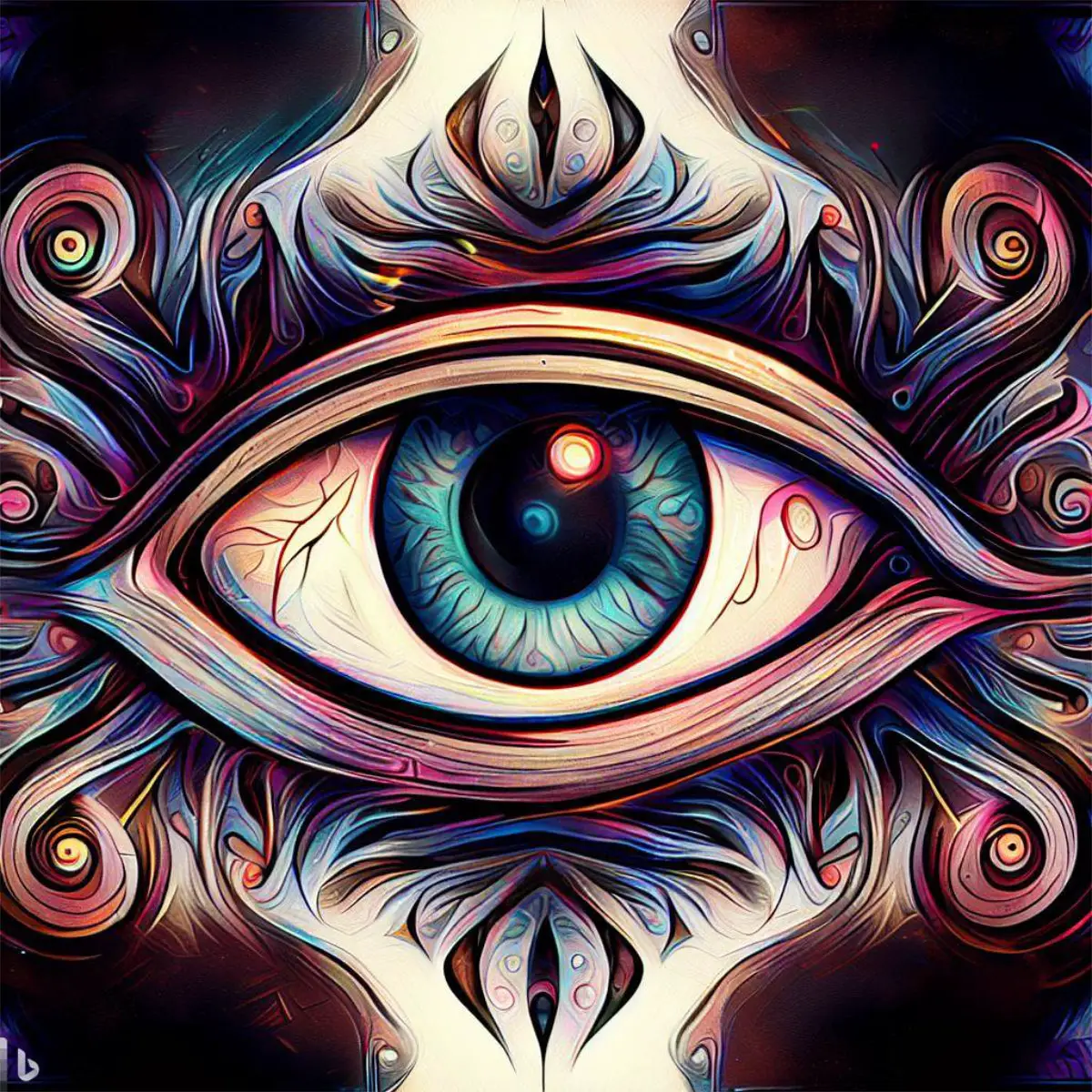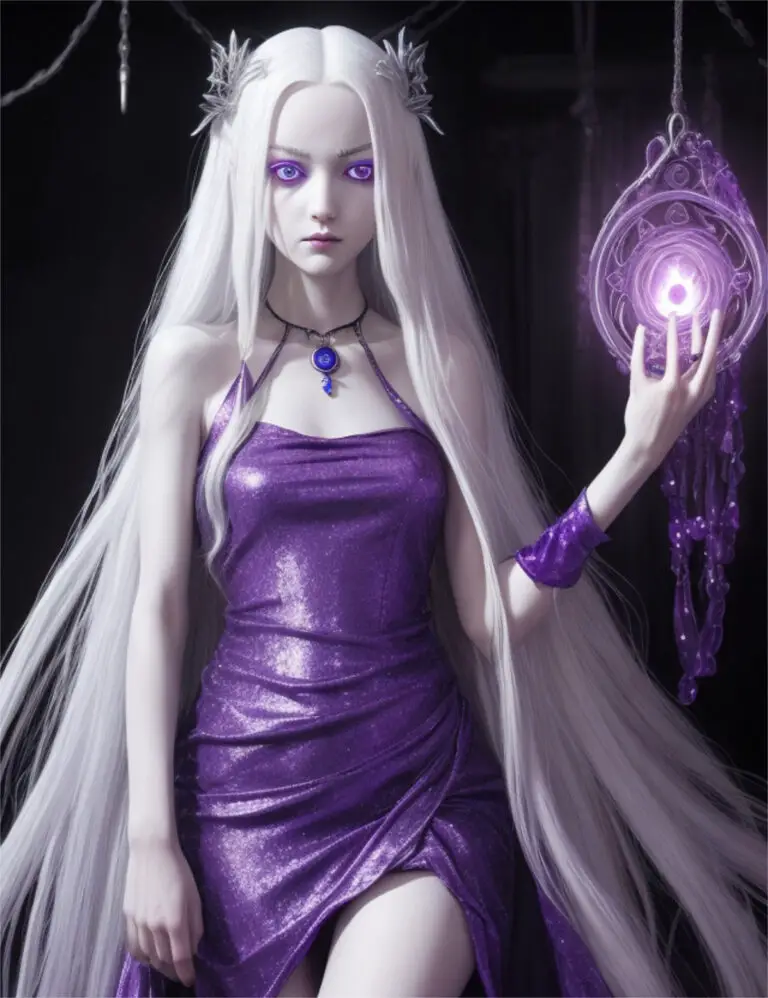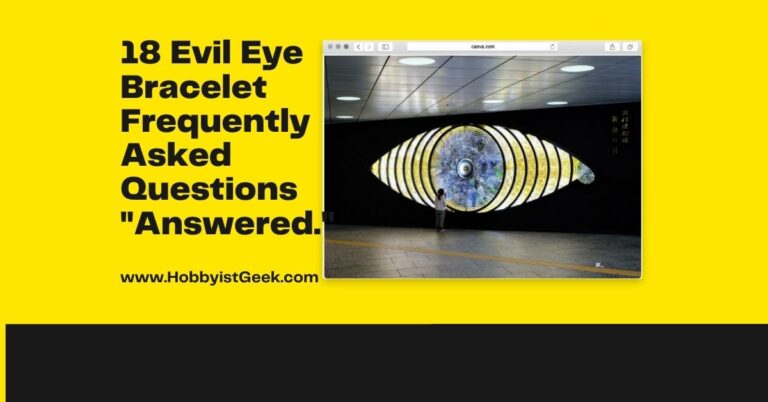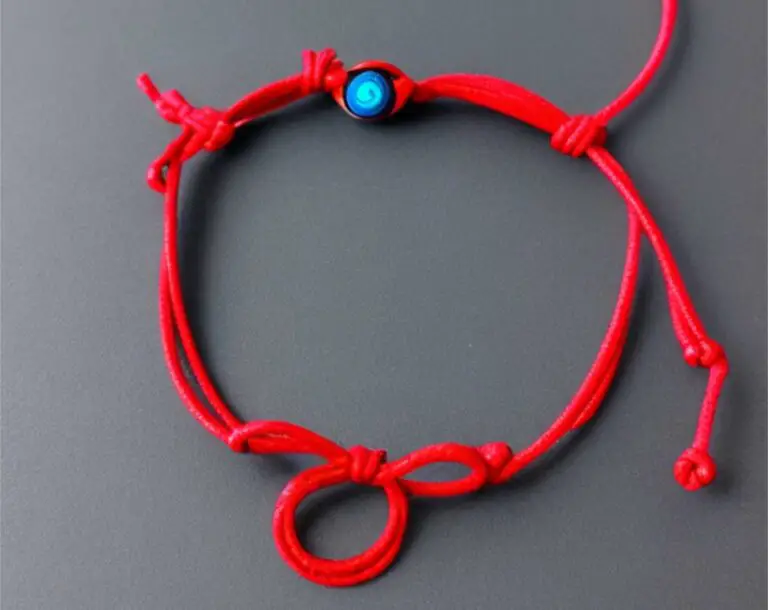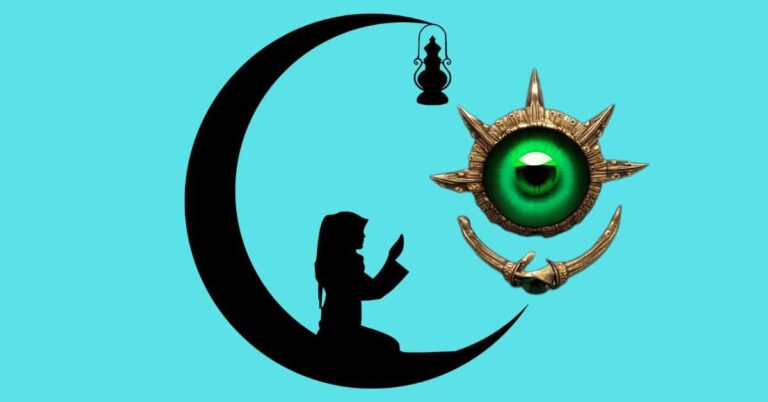Evil Eye Symbol: Life Transformation | Must Read
Article Takeaway
The Nazar symbol, also known as the evil eye, carries a rich history and is believed to protect against negative energy and envious gazes.
People integrate it into tattoos, nail art, and written communication, using it as a shield against harm.
Originating from ancient civilizations like Egypt and Greece, it remains popular worldwide today, often represented by the blue eye emoji, symbolizing protection and positivity in various aspects of life.
The evil eye symbol, also known as the Nazar symbol, holds a fascinating meaning

Introduction
The Evil Eye Symbol, also known as the Nazar symbol, is a captivating and mysterious talisman with a rich history and profound significance. This ancient symbol has captured the imagination of cultures across the globe, from the Mediterranean to South Asia.
With its striking blue eye-like design, it is believed to possess protective qualities against malevolent forces and negative energy. In this article, we will explore the origins of the Evil Eye Symbol, its various meanings, and its significance in different contexts.
Origins of the Nazar Symbol: The origins of the Evil Eye Symbol can be traced back thousands of years to ancient Mesopotamia and Egypt.
It is believed that these civilizations regarded eyes as powerful symbols of protection and warding off evil spirits. The idea behind the Evil Eye Symbol is based on the belief that envious or malevolent glances can bring harm to individuals or their possessions.
To counteract this negative energy, people began using charms or amulets in the form of an eye. Nazar Symbol Meaning:
The Nazar symbol carries multiple meanings across cultures. One common interpretation is its ability to provide protection against ill-will or jealousy directed at you.
By wearing or displaying this ancient talisman, it is believed that you create a shield against negative energy and deflect any harm caused by envy or malice. Additionally, it signifies good luck and serves as a reminder to stay positive amidst life’s challenges.
Nazar Symbol for Protection at Home: Many individuals choose to incorporate the Nazar symbol into their homes as a means of safeguarding their living spaces from negativity.
Whether hung on doors or displayed prominently within interiors, it acts as a spiritual barrier that shields residents from evil intentions or harmful glances from outside sources. Moreover, families often view it as an emblematic representation of unity and love within their households.
Historical Context of the Nazar Symbol: Throughout history, numerous civilizations have revered and embraced the Nazar symbol.
From ancient Greece and Rome to Byzantine and Ottoman empires, this talisman has transcended time and culture. It has been a steadfast companion, accompanying people on their journeys, protecting their possessions, and warding off misfortune.
Its pervasive presence in various cultures underlines its enduring significance. Nazar Symbol as a Tattoo:
In recent years, the popularity of the Nazar symbol as a tattoo design has surged. People are choosing to permanently ink this enchanting eye onto their bodies as a personal form of protection.
The tattoo serves as a constant reminder that they are shielded from negativity and can overcome any challenges that come their way. Additionally, it is seen as a stylish and visually appealing choice due to its intricate details and vibrant blue color.
Significance of the Nazar Symbol: The significance of the Nazar symbol lies not only in its protective qualities but also in its ability to foster positive energy.
By wearing or displaying this symbol, individuals can cultivate an optimistic mindset and attract good fortune into their lives. Moreover, it encourages self-confidence by reminding us that we have the power to overcome adversity and rise above negativity.
These captivating aspects make the Evil Eye Symbol not just an ordinary talisman but also an embodiment of hope, resilience, and spiritual strength in various cultural contexts. In the following sections of this article, we will delve deeper into specific aspects such as the symbolism within religious texts, incorporating it into nail art designs, and understanding its representation through emojis in today’s digital age.
What Is the evil eye symbol?
The evil eye symbol, also known as the Nazar symbol, is a powerful and widely recognized talisman used for protection against the malevolent gaze of others. It has a rich history and cultural significance across various regions and religions.
The Nazar symbol can be found in written communication, such as texts and emails, where it is used to ward off any negative energy or ill intentions directed towards the recipient. In historical context, the Nazar symbol dates back thousands of years.
Its origins can be traced to ancient civilizations like the Mesopotamians, Egyptians, and Greeks, who believed in its ability to safeguard against evil forces. The concept behind this symbol lies in the belief that some individuals possess an envious or malicious eye that can bring harm or misfortune upon others.
The Nazar symbol acts as a countermeasure by deflecting this negative energy away from its wearer. Many people choose to incorporate the Nazar symbol in their homes as a means of protection against the evil eye.
It is commonly seen hanging on walls or doors as an amulet or charm. By displaying this talisman prominently in their living spaces, individuals believe they are shielding themselves from any potential harm that may arise from jealousy or ill wishes.
The Hamsa hand, another popular amulet for protection, often features the Nazar symbol within its design. This hand-shaped talisman with an eye at its center holds great significance across different cultures and religions.
In addition to providing defense against the evil eye, it is believed to bring blessings, good luck, and positive energy into one’s life. Artists and designers have been inspired by the symbolism of the Nazar throughout history.
They create intricate artwork and unique designs incorporating this powerful talisman. From jewelry pieces like necklaces and bracelets adorned with miniature versions of the emblem to home decor items showcasing elaborate patterns with vibrant colors resembling eyes – these creations are not only aesthetically pleasing but also serve as a constant reminder of protection and warding off negativity.
The name “Nazar” itself holds significance, derived from the Arabic word “nazar,” meaning “sight” or “glance.” This term perfectly encapsulates the intent behind the symbol – to avert any harmful intentions directed through the act of looking. The Nazar symbol serves as a visual representation of this concept, with its vivid blue color often associated with protection and good fortune.
Using the Nazar symbol has numerous advantages. Apart from its protective qualities, it can instill a sense of calm and reassurance in individuals who believe in its power.
It provides a psychological shield against negative energy, enhancing one’s overall well-being and confidence. Whether worn as jewelry, displayed at home, or integrated into various forms of art, this talisman acts as a constant reminder to stay positive and ward off any harm that may come your way.
In religious texts like the Quran and the Bible, references can be found that allude to concepts similar to that of the evil eye. Islam also mentions specific prayers for protection against envy and evil spirits.
However, it is important to note that interpretations vary across different cultures and religious beliefs. The popularity of the Nazar symbol has led many individuals to permanently ink it on their bodies as tattoos.
These tattoos serve as personal expressions of faith, belief in protection, or simply admiration for its aesthetic appeal. The design possibilities are endless when it comes to incorporating the Nazar symbol into body art – from small minimalist designs to elaborate compositions featuring additional symbols or elements such as flowers or birds.
In today’s digital world, even emojis have become part of our communication landscape. The Nazar symbol emoji features an eye-like image often depicted within concentric circles in shades of blue.
Its interpretation varies slightly but generally signifies protection against negative energies or casting off evil intentions. These are just some aspects that shed light on what exactly is meant by the evil eye symbol, or more specifically, the Nazar symbol.
Understanding its origins, cultural significance, and the belief systems surrounding it allows us to appreciate its power as a protective talisman against harm and misfortune. Its presence in our lives serves as a reminder to stay positive, ward off negativity, and navigate through life’s challenges with confidence and resilience.
What Is the evil eye symbol meaning?
The evil eye symbol has a deep and intriguing meaning that spans across various cultures and time periods. Known as the Nazar symbol, it is believed to provide protection against the malevolent gaze of others.
The term “Nazar” originates from the Arabic word for “sight” or “glance,” emphasizing its association with warding off envious eyes. The Nazar symbol holds great importance in many Middle Eastern, Mediterranean, and South Asian cultures where it is commonly used as a talisman.
Its significance lies in its ability to shield individuals from harm caused by jealousy or ill intentions directed towards them. The belief in the evil eye’s power goes back centuries, with references found in ancient texts and folklore from around the world.
Throughout history, people have embraced the Nazar symbol for its protective qualities. Placing it in homes or wearing it as jewelry is believed to bring good fortune and deflect negative energies.
This ancient motif often takes the form of a blue amulet adorned with concentric circles or a stylized eye design resembling an open hand. It serves as a reminder to stay vigilant against harmful influences that may come one’s way.
The use of the Nazar symbol extends beyond physical objects; it has also become integrated into modern communication practices. In written communication, such as text messages or social media posts, people often include emojis resembling the evil eye to convey thoughts of protection or warding off any negativity directed towards them or others.
This modern interpretation of the symbol reveals its enduring relevance and adaptability in an ever-evolving world. The meaning behind the evil eye symbol, also known as the Nazar symbol, encompasses protection against envy and negative energy.
Its origins can be traced back through centuries of cultural beliefs and traditions throughout various regions worldwide. Whether used as an amulet at home, incorporated into nail art designs, interpreted as tattoos, or even utilized within digital communications through emojis, this powerful talisman has stood the test of time, providing individuals with a sense of security and guarding them against the ill effects of the malevolent gaze.
What is the Evil Eye Symbol? Should I be worried?
What Is the evil eye symbol origin?
The origin of the evil eye symbol, also known as the Nazar symbol, can be traced back to ancient civilizations. Its history is deeply rooted in several cultures, most notably in the Middle East and the Mediterranean region. The exact origin of this powerful talisman is a subject of debate among scholars and historians.
One popular belief regarding the origin of the evil eye symbol dates back to ancient Greece and Rome. It is said that during these times, people believed that certain individuals possessed the power to cast curses or inflict harm simply through their envious gaze.
To protect themselves from this malevolent influence, they began using amulets or charms adorned with an eye-like design. Another theory suggests that the evil eye symbol originated in ancient Egypt.
The ancient Egyptians believed in “the Eye of Horus,” which was considered a protective amulet against evil forces. Over time, this concept spread across different cultures and evolved into what we now know as the evil eye symbol.
Furthermore, traces of this powerful talisman can be found in various religious texts such as the Bible and Quran. In these texts, there are references to protecting oneself from envy and negative energies through symbols resembling an eye.
This further solidifies its importance and widespread recognition throughout history. While there are multiple theories surrounding its origin, it is evident that the evil eye symbol has a rich historical context rooted in various cultures worldwide.
Whether derived from Greek mythology or ancient Egyptian beliefs, its significance as a protective talisman has transcended time and borders. Today, it continues to be embraced by many for its potent symbolism against negative energies and envious gazes.
What Is the evil eye symbol name?
The evil eye symbol goes by various names across different cultures and regions. One of the most common names for this symbol is the “Nazar” symbol. This name originates from the Turkish word “nazarlik,” which means “to ward off the evil eye.” The Nazar symbol holds great significance in Turkey, where it is believed to protect against malevolent glares and negative energy.
The origins of the Nazar symbol can be traced back to ancient civilizations, particularly in the Mediterranean and Middle Eastern regions. The concept of protecting oneself from the evil eye has been prevalent for centuries, with different cultures developing their own interpretations and variations of this powerful amulet.
The Nazar symbol is often associated with a blue glass bead or an eye-shaped design that embodies spiritual protection. In many homes in Turkey, you will find the Nazar symbol hanging prominently at doorways or windows as a talisman against ill-wishing and envy.
It is believed that these symbols have the power to deflect negative intentions, ensuring a harmonious atmosphere within the household. Additionally, some individuals choose to incorporate the Nazar symbol into their interior decor as an artistic element that also serves as a protective charm.
The popularity of the Nazar symbol extends beyond traditional beliefs and customs. In recent years, it has gained traction as a tattoo design across various cultures worldwide.
People choose to permanently ink this emblem on their skin as a personal form of protection or simply for its aesthetic value. The intricate designs often showcase creative twists on traditional interpretations, serving as unique expressions of individual style while still acknowledging its historical context.
Overall, whether referred to as the evil eye or by its more specific name – the Nazar symbol – it remains an emblem rich in meaning and history across cultures globally. Its ability to safeguard against negative energies continues to resonate with people seeking protection and positive vibes in their lives.
What does the evil eye symbol represent?
| Aspect | Meaning and Significance |
|---|---|
| Representation | The evil eye symbol, also known as the Nazar symbol, holds significant meaning across different cultures and time periods. It is represented by a vibrant blue eye-shaped design, exuding mystique and intrigue. |
| Origins | The symbol’s origins can be traced back to ancient civilizations like Mesopotamia, Egypt, and Greece, where it was believed that certain individuals possessed the ability to cast an envious or harmful gaze through their eyes. |
| Protection | It is believed to provide protection against the malevolent gaze and negative energy. In religious texts of Judaism, Islam, and Christianity, references are made to the concept of the evil eye and its potential harm, and the Nazar symbol serves as a protective amulet against envy and ill intentions. |
| Home Use | Many people hang or place the Nazar charm in their homes to ward off negativity and invite positive energy. It acts as a constant reminder to stay vigilant against harmful influences and maintain a harmonious atmosphere. |
| Tattoos | The evil eye symbol is often chosen as a tattoo, with its intricate artwork making captivating designs. Tattoos serve as a form of personal protection and can also be chosen for aesthetic purposes. |
| Nail Art | Nail art enthusiasts incorporate the Nazar symbol into their creative designs, adding a sense of spiritual awareness to everyday life. This can range from minimalist representations on individual nails to elaborate patterns spanning all fingers. |
| Digital Usage | In modern communication, there is an emoji that closely resembles the Nazar symbol, often used to express caution or ward off negativity in digital conversations. |
| Universal Symbol | The evil eye symbol universally represents protection from the malevolent gaze and negative energies. Its significance spans various cultures and religious beliefs, serving as a reminder to ward off envy and ill intentions while embracing positive energy. |
The evil eye symbol, also known as the Nazar symbol, holds significant meaning across different cultures and time periods. This powerful symbol is believed to provide protection against the malevolent gaze and negative energy. Represented by a vibrant blue eye-shaped design, it exudes an air of mystique and intrigue.
The origins of the evil eye symbol can be traced back to ancient civilizations such as Mesopotamia, Egypt, and Greece. In these cultures, it was believed that certain individuals possessed the ability to cast an envious or harmful gaze upon others through their eyes.
The Nazar symbol was then created as a talismanic representation to ward off this malevolent power. In many religious texts, including those of Judaism, Islam, and Christianity, references are made to the concept of the evil eye and its potential harm.
In these traditions, it is acknowledged that jealousy can manifest in destructive ways. Thus, wearing or displaying the Nazar symbol acts as a protective amulet against envy and ill intentions from others.
The evil eye symbol is commonly used for protection within homes as well. Many people hang or place the Nazar charm in their living spaces to ward off negativity and invite positive energy into their surroundings.
It serves as a constant reminder to stay vigilant against harmful influences and maintain a harmonious atmosphere within one’s abode. Furthermore, one of the advantages of incorporating the Nazar symbol in various forms is its versatility.
People often choose to get tattoos featuring this enchanting design as a permanent form of personal protection or even simply for aesthetic purposes. The intricate artwork associated with the evil eye makes for captivating tattoo designs that hold deep significance for those who wear them.
Additionally, nail art enthusiasts have found ways to incorporate the Nazar symbol into their creative designs. From minimalist representations on individual nails to more elaborate patterns spanning across all fingers, incorporating this powerful emblem adds an element of spiritual awareness into everyday life.
In modern communication, the evil eye symbol is also prevalent. With the rise in popularity of emojis, there is an emoji that closely resembles the Nazar symbol.
This particular emoji is often used to express a sense of caution or warding off negativity in digital conversations. In essence, the evil eye symbol represents protection from the malevolent gaze and negative energies.
Its significance spans across various cultures and religious beliefs, making it a universal symbol for warding off envy and ill intentions. Whether worn as a tattoo, displayed in artwork or designs, or incorporated into nail art, this captivating emblem serves as a powerful reminder to stay vigilant against harmful influences and embrace positive energy.
What Is the evil eye symbol of history?
The evil eye symbol holds a significant place in history, with its origins tracing back to ancient civilizations. The symbol, also known as the Nazar or the Blue Eye, has been used across various cultures as a means of protection against the malevolent gaze of others.
Its historical context reveals fascinating insights into the beliefs and practices of different societies. The Nazar symbol finds its roots in ancient Egyptian and Mesopotamian civilizations, where it was believed to ward off evil spirits and protect against harm.
As we delve deeper into history, we find references to similar protective amulets in Ancient Greece and Rome. These amulets were often shaped like an eye or featured an eye motif to deflect negative energy.
In some cultures, the Nazar symbol is associated with religious beliefs. It is believed to have connections with both Islam and Judaism.
In Islam, it is known as the “Nazar boncuk” or “Mavi boncuk,” which translates to “blue bead.” The symbol is widely used in Turkey and other regions influenced by Turkish culture. Similarly, in Judaism, the Hamsa hand is often combined with the Nazar symbol for added protection against the evil eye.
Throughout history, people have embraced the Nazar symbol for its perceived power of protection against envy and ill intentions from others. Its influence can be seen not only in physical adornments but also in written communication.
From jewelry and accessories to home decor items like wall hangings or talismans hung above doorways, this age-old symbol has represented a defense mechanism against negative energy. Whether depicted on pottery from ancient civilizations or incorporated into modern-day artwork and designs, the historical significance of the evil eye symbol cannot be undermined.
It continues to remain relevant today as people seek ways to safeguard themselves from negativity while appreciating its aesthetic appeal at the same time. Understanding the historical context of the evil eye symbol provides us with a glimpse into the beliefs and customs of ancient civilizations.
It has evolved over time to become a widely recognized emblem of protection against the malevolent gaze. From its origins in ancient Egypt and Mesopotamia to its prevalence in various cultures, this symbol’s enduring presence speaks to its universal appeal and enduring relevance.
What Is the evil eye symbol in the bible?
The evil eye symbol holds a significant place in various religious texts, and its presence in the Bible is no exception. While it may not be explicitly mentioned as the “evil eye” symbol, there are references to the concept of an envious or malevolent gaze that align with the symbolism associated with the evil eye.
In biblical passages such as Proverbs 23:6-8 and Matthew 20:15, there are warnings against covetousness and envy. These passages caution against being consumed by jealousy and desiring what others possess.
The idea behind these warnings is that harboring envious thoughts can lead to negative consequences, both for one’s own spiritual well-being and for relationships with others. Though the term “evil eye” itself may not be mentioned, the essence of protection from an envious gaze is present in various stories.
For instance, Psalm 121:7-8 speaks about divine protection from harm and states that “the Lord shall preserve thee from all evil.” This can be interpreted as a shield against any ill will directed towards oneself. It is important to note that while the evil eye symbol itself may not have a direct reference in the Bible, its concept aligns with biblical teachings on guarding oneself against envy and seeking divine protection.
This connection further reinforces the symbolism and significance attributed to this powerful symbol across different cultures and religions. So when delving into discussions about symbols like Nazar artwork or designs, understanding their historical context within religious texts like the Bible adds depth to their interpretation and highlights their relevance in providing spiritual guidance to followers.
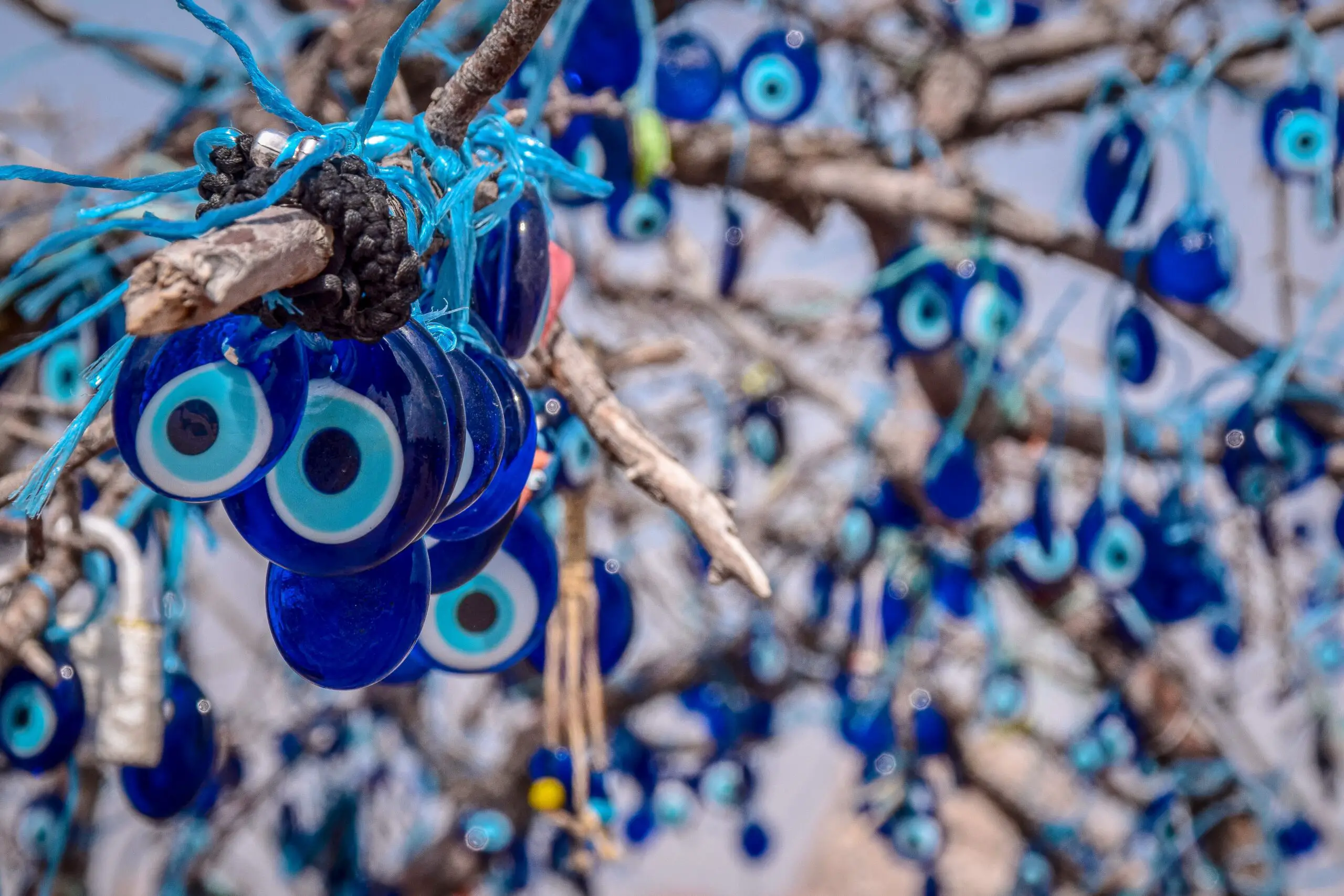
The Evil Eye and Psychic Protection
Udemy Course
Unlock a Life of Protection and Positivity:
Defend Yourself from the Evil Eye with Psychic Self-Defense
Are you tired of feeling like life is an uphill battle? Do accidents, injuries, money problems, and chronic illnesses seem to follow you relentlessly? Have you ever wondered if there’s an unseen force working against you? The answer might lie in the mysterious phenomenon of the Evil Eye and psychic attacks. But fear not, because we have the solution that could transform your life.
Why is it crucial to master the techniques taught in this course?
Imagine a life where you’re shielded from negative energies and free from unintentionally casting the Evil Eye upon others. Envision a reality where accidents are replaced with opportunities and struggles are swapped for triumphs. Our course opens the doors to such a life-changing transformation by equipping you with powerful psychic self-defense skills.
Introducing Our Enhanced Course Experience
Dive into a learning journey like no other, with our newly upgraded video and audio quality that ensures an immersive and engaging educational experience. Get ready to unravel the mysteries of the Evil Eye and psychic attacks as we guide you through the following:
1
Understanding the Evil Eye
Delve into the heart of this ancient concept. Gain insights into what it is and how it affects lives without discrimination.
2
Decoding Psychic Attacks
Explore the intricacies of psychic attacks and learn how they can disrupt your life on multiple levels.
3
Symptoms and Solutions
Recognize the telltale signs of the Evil Eye’s influence in your life and discover powerful antidotes to counter its effects.
4
Reclaim Your Power
Uncover techniques to retrieve your lost personal power and regain control over your destiny.
5
Casting Out Negativity
Learn to identify if you’ve unknowingly cast the Evil Eye upon others and how to reverse its impact using a special mantra tailored to your needs.
6
Healing and Protection
Acquire an arsenal of methods to safeguard yourself from the Evil Eye and psychic attacks, ensuring a life of positivity and wellness.
Why This Course Matters:
This isn’t just another course; it’s your path to liberation. Imagine the relief of breaking free from the curse of negative energies, hexes, and psychic forces that have held you back for far too long. Experience the joy of a life filled with abundance, wellness, and genuine connections.
Enroll Now and Embrace a Brighter Future
Are you ready to bid farewell to struggles and embrace a life of fulfillment? Our course is meticulously designed to empower you with knowledge and techniques that will forever change your trajectory. Don’t let the shackles of negativity hold you captive any longer. Join us in this transformative journey and unlock a realm of protection, positivity, and personal growth.
Enroll today and embark on a transformative journey toward protection, positivity, and personal growth!
What Is the evil eye symbol for home?
The evil eye symbol holds a special place when it comes to protecting our homes. In many cultures, the evil eye symbol for home is believed to ward off negative energy and protect against any ill-intentioned gaze that may be directed towards our living spaces. This ancient amulet, also known as the Nazar symbol, has been used for centuries as a powerful talisman against misfortune and harm.
When it comes to the Nazar symbol’s significance within our homes, its primary function is to create a shield of protection. The belief is that by placing the evil eye symbol at the entrance or inside our homes, we can prevent any malevolent forces from entering.
Its presence acts as a constant guardian, offering solace and reassurance to those dwelling within its protective embrace. Moreover, incorporating the Nazar symbol into our home decor not only serves as a means of protection but also adds an element of beauty and spirituality.
Many individuals choose to hang or display Nazar symbol-inspired artwork or decorative items in their homes due to their intricate designs and vibrant colors. These pieces act as captivating focal points while simultaneously serving as reminders of the positive energy surrounding them.
The incorporation of the Nazar symbol extends beyond physical objects; it can also be found in nail art designs adorning fingertips worldwide. By depicting this powerful talisman on one’s nails, individuals carry with them a sense of spiritual protection wherever they go.
Whether displayed discreetly or boldly on each nail, these miniature representations serve as constant reminders of strength and ward off any potential negative influence. The evil eye symbol for home holds immense significance in various cultures worldwide.
Its purpose is not only to safeguard our living spaces from negative energies but also to infuse beauty and spirituality into our surroundings. Whether displayed at entrances or integrated into home decor, this talisman offers both practical protection and an aesthetic appeal that captures hearts across generations.
What Is the evil eye symbol tattoo?
The evil eye symbol tattoo has become increasingly popular in recent years, with individuals looking to adorn their bodies with this ancient and powerful symbol. The tattoo is an artistic representation of the Hamsa hand and Nazar symbol, often intricately designed to capture the essence of protection and ward off evil spirits.
People choose to have the evil eye symbol tattooed on various parts of their bodies, including the wrist, forearm, or even as a larger back piece. The significance of the evil eye symbol as a tattoo lies in its protective properties.
Just as the Nazar symbol is believed to guard against malevolent forces and bring good luck, those who sport this tattoo hope to benefit from its protective aura. The ancient origins and deep-rooted beliefs associated with the Nazar symbol make it an attractive choice for many seeking a permanent reminder of their spiritual beliefs and desire for protection.
One advantage of using the evil eye symbol as a tattoo is its versatility. The design can be adapted in various ways to suit individual preferences and styles.
Some may opt for a simple yet elegant rendition, while others may choose to incorporate vibrant colors or intricate patterns into their tattoos. This flexibility allows each person to personalize their evil eye symbol tattoo while still maintaining its core symbolism.
In written communication, such as text messages or social media posts, incorporating the evil eye symbol emoji can convey various meanings. It can represent one’s belief in protection against negativity or serve as a wish for good fortune upon someone else.
However, it’s important to note that interpretation may vary depending on cultural backgrounds and personal understanding of symbols. Overall, whether donned permanently on one’s skin or used digitally in conversation, the evil eye symbol holds significant meaning across cultures and time periods.
Its long-standing presence in religious texts and historical context only further add depth to its symbolism. So if you’re considering an evil eye symbol tattoo or using it in your online exchanges, remember that you are embracing a powerful symbol of protection, luck, and spirituality.
What Is the evil eye symbol emoji?
The evil eye symbol emoji, also known as the Nazar symbol emoji, has gained popularity in recent years due to its unique and captivating design. This emoji features a blue eye with a dark circle in the center and a series of smaller circles around it, representing the protective power of the evil eye symbol.
Just like its real-life counterpart, this emoji is believed to ward off negative energy and protect against the evil eye. The interpretation of the Nazar symbol emoji varies among different cultures and individuals.
Some people see it as a talisman for protection at home, using it to shield their living spaces from harmful influences. Others incorporate the Nazar symbol in nail art as a stylish way to carry its protective essence wherever they go.
Its vibrant colors and intricate patterns make for stunning designs that catch everyone’s attention. The significance of the Nazar symbol goes beyond its aesthetic appeal.
In many cultures, it is considered a powerful amulet that safeguards against misfortune and ill intentions. Its name comes from the Turkish word “nazar,” which means “gaze” or “evil eye.” The belief in the evil eye spans across centuries, with historical references dating back to ancient civilizations such as Mesopotamia and Egypt.
In written communication, using the Nazar symbol emoji can convey different meanings depending on context. It can be used to indicate protection or warding off negativity, similar to how people use phrases like “knock on wood” or “fingers crossed.” Additionally, some individuals choose to get tattoos of this symbol as a permanent reminder of its protective qualities.
The advantages of using the Nazar symbol are not only rooted in folklore but also extend into modern-day life. By embracing this ancient talisman through symbols like an emoji or tattoo, individuals can tap into a sense of comfort and security while navigating daily challenges.
Overall, whether you interpret it as an emblem against malevolent forces or simply appreciate its aesthetics, the Nazar symbol emoji offers a captivating representation of a centuries-old belief system. Its rich historical context, versatile applications, and ability to convey protection in written communication make it a fascinating symbol that continues to capture our collective imagination.
What Is the evil eye hand symbol?
The evil eye hand symbol, also known as the Nazar symbol, is a powerful and protective gesture that has been used for centuries to ward off negative energy and bring good fortune. This symbol is commonly depicted as a hand with an eye in the center, representing the all-seeing power that can protect against the malevolent gaze of others. In many cultures, including Middle Eastern and Mediterranean traditions, the evil eye hand symbol holds significant meaning.
It is believed to have originated from ancient practices aimed at preserving spiritual well-being and protecting individuals from harm. The Nazar symbol is often incorporated into various forms of art, including tattoos and nail art, serving as a visual reminder of its protective qualities.
One of the advantages of using the Nazar symbol is its versatility in design and interpretation. Artists and designers have created countless variations of this symbol, each with its own unique flair.
From intricate hamsa hands adorned with detailed patterns to simple yet elegant single eye motifs, there are endless possibilities when it comes to incorporating this powerful emblem into your personal style or home decor. Beyond its aesthetic appeal, the Nazar symbol also carries deep spiritual significance.
It has been referenced in religious texts such as the Quran and Bible as a safeguard against envy and evil forces. The belief in its protective nature extends beyond religious contexts, with many people embracing it as a universal talisman for warding off negativity.
Whether you choose to wear it as a tattoo or incorporate it into your daily life through artwork or jewelry, the evil eye hand symbol carries with it a rich historical context rooted in centuries-old traditions. Its origins may be shrouded in mystery, but its enduring popularity speaks volumes about its enduring appeal and relevance in our modern world where protection against negative energies remains an essential aspect of our well-being.
What Are the benefits of the evil eye symbol?
| Benefits of the Evil Eye Symbol |
|---|
| 1. Protection |
| Believed to ward off negative energy and protect against malevolent forces, the evil eye symbol serves as a shield against the harmful effects of jealousy and envy. |
| 2. Versatility |
| Whether displayed in written communication, worn as jewelry, or incorporated into artwork and designs, the Nazar symbol’s significance remains unwavering, making it adaptable to various forms of expression. |
| 3. Generational Safeguard |
| Passed down through generations, the Nazar symbol safeguards homes and loved ones from harm. It offers not only physical protection but also a reminder to stay vigilant against negativity in life. |
| 4. Aura of Positivity |
| Its presence creates an aura of positivity and shields individuals from ill intentions, promoting well-being and harmony. |
| 5. Religious Significance |
| Found in religious texts like the Quran and Bible, the evil eye concept underscores the universal importance of the Nazar symbol, even though interpretations may vary across cultures and religions. |
| 6. Aesthetic Appeal |
| Many choose to incorporate the symbol into tattoos and nail art, appreciating its aesthetic appeal alongside its protective qualities. |
| 7. Positive Energy Source |
| By integrating the Nazar symbol into daily life, individuals can cultivate environments free from envy-induced harm, fostering inner peace and positive relationships. |
| 8. Transcultural Value |
| The symbol’s benefits transcend cultural boundaries, making it an invaluable tool for warding off negative energies and promoting a life filled with positivity and abundance. |
The evil eye symbol, also known as the Nazar symbol, holds a plethora of benefits that make it highly sought after in various cultures around the world. One of the primary advantages of using the evil eye symbol is its protective nature.
Believed to ward off negative energy and protect against malevolent forces, this ancient talisman acts as a shield against the harmful effects of jealousy and envy. Whether it is displayed in written communication such as texts or emails, worn as jewelry like the popular Hamsa hand with a Nazar symbol charm, or incorporated into intricate artwork and designs, its significance remains unwavering.
Throughout history, civilizations have embraced the Nazar symbol for its protective properties. It has been passed down from generation to generation as a way to safeguard homes and loved ones from harm.
This powerful amulet not only offers physical protection but also serves as a reminder to stay vigilant against negativity in all aspects of life. Its presence creates an aura of positivity and shields individuals from the ill intentions of others.
In religious texts such as the Quran and Bible, references to evil eyes can be found, further highlighting the significance of this universal symbol. The Nazar symbol’s interpretation may vary slightly across different cultures and religions; however, its essence remains rooted in warding off harmful energies that may disrupt one’s well-being.
People often choose to get tattoos featuring the evil eye or incorporate it into nail art designs not only for its aesthetic appeal but also for its protective qualities. Incorporating the Nazar symbol into daily life brings forth numerous advantages.
It serves as a constant source of positive energy and encourages individuals to lead happier and more harmonious lives by deflecting negativity that may come their way. By embracing this ancient talisman, one can cultivate an environment free from envy-induced harm while fostering peace within oneself and with others.
Overall, whether utilized through written communication like emojis or messages infused with good intentions or adorned as a beautiful piece of jewelry or artwork, the evil eye symbol and its benefits transcend cultural boundaries. Its protective nature has withstood the test of time, making it an invaluable tool in warding off negative energies and promoting a life filled with positivity and abundance.
What Are evil eye symbol designs?
When it comes to evil eye symbol designs, the possibilities are endless. From traditional to contemporary, there are numerous ways to incorporate this powerful symbol into various art forms.
One of the most common designs is the eye itself, usually depicted in shades of blue or green. The eye is often surrounded by intricate patterns and embellishments, adding a touch of elegance and mystique to the overall design.
Some artists choose to focus solely on the eye, while others prefer to include additional symbols like the Hamsa hand or other protective motifs. Incorporating the Nazar symbol in nail art has become increasingly popular in recent years.
Nail technicians create stunning designs using vibrant colors and intricate details to capture the essence of this ancient symbol. Some opt for a minimalist approach and simply paint a single eye on each nail, while others go all out with elaborate patterns that cover every inch of their nails.
The significance of the Nazar symbol as a talisman for protection makes it an ideal choice for those who want their nails not only to look stylish but also carry a symbolic meaning. For those considering getting a tattoo, incorporating the Nazar symbol is an excellent choice.
The eye can be inked anywhere on the body and can be as small or large as desired. Many people choose to place it on areas such as the wrist or behind their ear for a subtle yet meaningful touch.
The tattoo’s size and design can vary greatly depending on personal preference – some prefer a simple outline of an eye whereas others opt for detailed tattoos with vibrant colors and intricate patterns. Evil eye symbol designs offer a wide range of possibilities for artistic expression across different mediums such as nail art and tattoos.
Whether you prefer traditional or modern interpretations, incorporating this ancient talisman into your chosen art form can add both style and symbolism to your life. From its origins rooted in history and religious texts to its current use as protection at home or even in written communication, the Nazar symbol continues to captivate and inspire with its remarkable versatility.
What Is the evil eye symbol on nails?
Incorporating the evil eye symbol into nail art has become a popular trend in recent years. Nail artists and enthusiasts alike have embraced this mystical symbol as a unique and eye-catching design element.
Whether it’s a subtle accent or the main focus of the manicure, the evil eye symbol on nails adds an intriguing touch to any style. When it comes to creating nail art with the evil eye symbol, there are various approaches one can take.
Some may opt for a minimalist design, featuring a single evil eye on one nail as a statement piece. This allows for intricate detail work, showcasing the intricate patterns and vibrant colors associated with the symbol.
Others may choose to adorn multiple nails with smaller evil eye symbols, creating a cohesive pattern that extends across the entire hand. The incorporation of different colors is also key when designing evil eye symbols on nails.
Traditionally, blue is believed to be the most protective color against the malevolent gaze of envy and ill-wishing. However, modern interpretations often feature diverse color schemes to match personal preferences or overall nail art themes.
From bold blues contrasting with whites and gold accents to vibrant rainbow hues that make each evil eye stand out, there are endless possibilities for creative expression. Whether you choose to create your own nail art featuring this ancient protective talisman or seek professional help from a skilled nail artist, incorporating the evil eye symbol onto your fingertips adds an element of mystique and charm.
It not only showcases your personal style but also serves as a reminder of protection against negative energies and ill intentions in everyday life. So next time you’re looking for some inspiration for your next manicure, consider adding that captivating and mesmerizing evil eye symbol onto your nails!
What Is the evil eye symbol in the text?
The evil eye symbol, also known as the Nazar symbol, holds a significant place in various cultures and is often incorporated into text to convey a sense of protection or ward off negativity. In written communication, the Nazar symbol is commonly used to represent the belief in its power to safeguard against the evil eye. Incorporating this age-old talisman into text is believed to infuse it with protective energy and shield the reader from harm.
The origins of the Nazar symbol trace back to ancient civilizations such as Mesopotamia and Egypt. This powerful amulet was created to protect against malevolent gazes believed to cause misfortune or harm.
Today, it has become widely recognized across cultures as a potent symbol of protection from envy and ill-wishing. With its distinctive blue glass eye design surrounded by concentric circles in white and blue, it has become an iconic representation of safeguarding against negative energy.
In religious texts, the mention of the evil eye and its symbolism can be found in different faiths worldwide. For instance, in Islamic traditions, the concept of “Al-`Ayn” refers to both jealousy and the actual harmful effects that arise from it.
The Nazar amulet is regarded as a powerful defense mechanism against these harmful energies caused by envious individuals. Similarly, in some Jewish traditions, there are references to “Ayin Hara,” which translates as “evil eye.” The use of the Nazar symbol provides spiritual protection against this perceived threat.
Whether used online or offline, incorporating the Nazar symbol into written communication carries deep meaning for many individuals seeking protection from negativity or envy. It serves as a visual reminder that one’s well-being should never be compromised by external influences seeking harm.
By including this ancient talisman within text messages or social media posts, individuals express their desire for safety and good fortune while keeping alive centuries-old beliefs associated with this powerful emblem. When encountering written text adorned with the Nazar symbol, remember its profound meaning and purpose.
This protective talisman has transcended time and borders, becoming a universal symbol of defense against the evil eye. Whether through religious texts, cultural beliefs, or personal expressions, the Nazar symbol continues to play a vital role in safeguarding individuals from negativity and preserving their well-being.
Conclusion
Incorporating the Nazar symbol in nail art has become a popular trend, allowing individuals to showcase their belief in its protective powers while adding a touch of style to their fingertips. Nail artists have come up with various creative designs featuring the Nazar symbol, ranging from simple and minimalist to intricate and eye-catching. The symbol is often depicted in vibrant blue shades, representing the traditional color associated with warding off the evil eye.
Some nail art enthusiasts even incorporate other elements such as hamsa hands or intricate patterns to further enhance the visual appeal of their designs. By adorning their nails with the Nazar symbol, individuals not only express their belief in its protective qualities but also make a fashion statement that is sure to catch attention.
In today’s digital age, written communication has taken on various forms, including texting and social media messaging. It’s not uncommon to see people incorporating emojis into their texts and online conversations as a means of expressing emotions or conveying ideas succinctly.
Interestingly, there is an emoji that closely resembles the Nazar symbol – 🧿. This emoji can be interpreted as a representation of protection against harm or ill fortune.
By using this emoji in conversations or captions on social media platforms, individuals can subtly invoke the symbolism associated with the Nazar symbol and convey their belief in its power. As we delve deeper into the origins and significance of the Nazar symbol, we discover its rich historical context rooted in ancient civilizations across various regions.
From ancient Egypt to Greece, from Turkey to India, variations of this powerful talisman have been present throughout history as symbols of protection against malevolent forces. The name “Nazar” itself originates from Turkish and Arabic languages, meaning “sight” or “glance.” In religious texts such as the Quran or Bible, references can be found that allude to concepts similar to those surrounding the Nazar symbol – beliefs about protecting oneself from evil influences and envious gazes.
The Nazar symbol holds a profound significance for many cultures and individuals worldwide. Its historical roots, use in religious texts, and versatile incorporation into various art forms demonstrate its enduring appeal and belief in its protective powers.
Whether it is displayed as an artwork, worn as jewelry or clothing accessories, incorporated into nail art or tattoos, or even used in written communication through emojis, the Nazar symbol continues to serve as a powerful talisman of protection and goodwill. By embracing the Nazar symbol and incorporating it into our lives, we can cultivate a sense of optimism and belief in our ability to ward off negativity and attract positive energy.
Frequently Asked Questions
What are some common beliefs surrounding the evil eye symbol?
The evil eye symbol is believed to protect against negative energy and ward off malevolent intentions. Many cultures believe that it safeguards against envy and ill-wishing from others.
It is also thought to bring good luck and fortune to those who wear or display it. Evil eye beliefs can vary across different regions and traditions, but the underlying concept remains consistent: a powerful talisman that shields the wearer from harm.
How far back does the history of the evil eye symbol go?
The history of the evil eye symbol dates back thousands of years, with traces found in ancient civilizations such as Mesopotamia, Egypt, Greece, and Rome.
Its roots can even be traced back to prehistoric times when early humans sought protection from unseen forces. This enduring belief in its power has led to its prominent presence across various cultures and religions throughout history.
Are there any superstitions associated with the evil eye symbol?
Yes, there are several superstitions associated with the evil eye symbol.
One such belief is that wearing or displaying the symbol can deflect someone’s gaze if they have ill intentions towards you or your possessions. Another superstition suggests that if someone compliments you while inadvertently giving you the “evil eye,” you should immediately touch a piece of iron or perform a specific ritual to counteract any potential negative effects.
What does the evil eye symbol mean in different cultures?
While there are variations, generally speaking, different cultures view the evil eye symbol as a protective amulet against harmful energy and misfortune caused by jealousy or envy.
In some cultures, it is believed that people possess an innate ability to cast “the evil eye” unintentionally through their gaze alone; hence why wearing or displaying this talisman is considered essential for protection.
Can I wear multiple evil eye symbols for added protection?
Wearing multiple evil eye symbols is not uncommon among those who believe in their protective power. Some people choose to wear multiple evil eye jewelry pieces, incorporating bracelets, necklaces, and earrings, to ensure comprehensive protection against the malevolent intentions of others.
However, it is important to note that the belief in their power varies from person to person, and the efficacy of multiple symbols is subjective. Remember, while the evil eye symbol has a rich history and cultural significance across many societies, it’s important to approach these beliefs with an open mind and respect for different traditions and perspectives.
Sources
Want Protection From The Evil Eye? Here’s What To Know, From Experts
- Jewelry Making Ideas: Seasonal Crystal Trends That Command Premium Prices - May 31, 2025
- Evil Eye Hand: Unveiling the Mystical Origins and Meanings - February 2, 2024
- Amegreen Amethyst Meaning: Discover the Hidden Magic! - February 2, 2024

